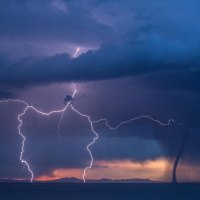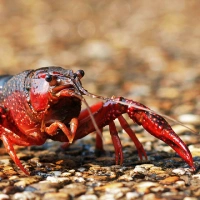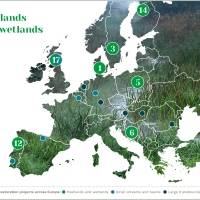Creativity and conservation: a Red List of creatures of Scandinavian folklore

Linnéa Jägrud is a limnologist based in Gothenburg, Sweden. Her work in MERLIN addresses peatland restoration in Sweden. Over the course of a year, Linnéa travelled with photographer Tore Hagman across Sweden to trace the landscapes of Nordic folkloric creatures called ‘vaesen’. As Linnéa explores in this guest article, their search for vaesen reveals the deeply-rooted cultural and historical connections to nature in Swedish landscapes. These connections can, in turn, deepen our modern-day understandings of ecological conservation and restoration.
+++
For thousands of years, we humans have changed our landscapes. The last century has been extra-hard for nature. Our formerly-rich environment has lost so much. Species are pushed aside towards Red Lists of Threatened Species. We must take better care of our Earth, so that all Earthlings can continue to exist.
The Scandinavian folklore creatures known as ‘vaesen’ are strongly connected to the landscape. For thousands of years, humans have passed on ancient stories about our Nordic vaesen. Men and women have seen them in the hide of the forest, or in the dim of the barn. A hint can be seen in the salt of the wave and the vortex of the stream. But what if the vaesen are more than just stories?
Or, even worse. What if we were not alone, but we are now? Could it be, that the landscape has changed so drastically that we have lost more than birds, meadows, bats and lichen? Could the vaesen also be on the Red List? And if so, what if we have also lost a piece of ourselves?

Living folklore in Swedish landscapes
Like a tree, this project was once a seedling in the head of Tore and I. Our idea rapidly grew into something more: a will to tell the story of the folkloric vaesen. And by tracing the landscapes of the vaesen across Sweden through photography, we wanted to offer a new perspective on modern-day conservation and restoration imperatives to “save and restore.”
With a common love for nature, with joy and creativity, sweat, laughter and some drops of blood, Tore and I took twenty-one photographs depicting the Nordic vaesen in the environments which birthed their folklore. The vaesen is strongly connected to the landscape. In the dark of the Swedish winter, it was easy to mistake a stump for a troll, or a rat for a tomte, a sort of gnome. Or maybe, these sightings were not mistakes?
Before electricity came, the vaesen was often seen and there are thousands stories about child being taken by trolls, women being drowned in the river, or men being seduced by the beautiful but dangerous “Lady of the Forest”. But there were equally as many stories about lost people who found their way thanks to the vaesen, or fishermen who got good catches after offering up a coin.

Creativity and conservation: photographing the vaesen
It is commonly known that the nature is, and always has been, a great inspiration for many artists and authors around the world. Some of the vaesen we photographed are still commonly known in Scandinavia, but not all of them. Through our work, we saw a strong correlation between the fragmentation and domestication of the landscape and the loss of vaesen folklore. The conservation of landscapes is not only about biodiversity, but folklore, too.
The further north in Sweden one goes, almost to Norway, the more time people spend in nature in their daily lives. It’s in these places that the vaesen folklore stays alive. Even further out, in Iceland, road construction is forced to take diversions around sites where folklore says that Icelandic elves dwell. In central Europe, with concrete, cities, intensive agriculture and irrigation systems, the beauty of the nature is so often lost, biodiversity is degraded and the folklore which springs from the landscape disappears. As a consequence, when we lose the stories which tie us to a landscape, we may lose the feelings which prompt us to conserve and restore its nature. And if we lose the love for the nature, we no longer consider it so important to keep.
I chose the locations for the photo shoots based on what would have been a suitable habitat for the vaesen. It required a lot of background research with folklore experts and Facebook groups. For example, for one shoot, I needed to find a horse that can actually stand still without someone holding it. And the horse needed to be in a lake with lilypads in the hair! Not all horses can do that, but eventually, after searching several social media groups, I found a very calm and nice horse named Brolle, who could do the job.
For the Kraken picture, we created a papier-mâché tentacle that is over three metres long, and had to transport it and the small wooden boat out in the sea. Papier-mâché, ocean, leaking wooden boat and rain is a very bad combination. The weather conditions were extremely important and at the very last second, the wind calmed down and we could take the shot. The Lady of the Mine picture required a visit to the mine of Taberg, south of Jönköping. It is a very old mine, but it closes during winter to protect the bats. Hence we had to hurry up and make our way between flying bats in the complete dark of the mountain, before it closed for half a year.
Using leftovers from a Viking house building, my husband Johannes and I built the exhibition frames for the photographs. We created “species-specific factsheets”, which included the last observation of the vaesen, its Red List category, biotope, threats, and measures to save it, which were printed directly on a metal plate. The sounds which accompanied the photographic exhibition were also very important. I carefully picked the appropriate birdsong for each environment, in order to evoke the sounds that surrounds the photos. Currently the exhibition is shown at Rydals Museum, on the west coast of Sweden. In the autumn, the exhibition is ready to tour and be shown in other places.

Freshwater folklore: a Red List of the vaesen
An important thing about these vaesen is their name. Many of the Scandinavian vaesen are named “rå” (raa). A rå is a vaesen that protects and take care of a certain place. Hence, the Skogsrå, the lady of the forest, is not only a good-looking women in the forest. She is the forest. She is a vital part of what we today would call the ecosystem. She takes care of the animals in the forest and guards the trees. Maybe that is why she used to seduce the timber men? Maybe she did not want them to cut the trees? The Havsrå, the mermaid, is another rå, who takes care about the coastal areas and guards it. She decides if the fishermen shall get fish, or not. There is also a rå in the mine, and she seems to prefer the bats and keep them safe during winter. Numerous stories tell that you must always be polite towards the rå. Greet them by name and give them some small gift, and you shall be greatly re-gifted. The Gruvrå (Lady of the Mine) could tell you if the mountain was safe to enter, and the mermaid could tell you when there was a storm coming in.
Our folkloric Red List is based upon how fragmented the vaesen’s environment is today. Trolls for example, need very old forests. Since almost all of the old forests have been cut down, the trolls are left to survive only in nature reserves and national parks. The nix, or Näcken in Swedish, is a water man that live in the strong wild stream. He is traditionally found to be playing the fiddle, and sometimes luring innocent humans into the stream. What will happen when there is a hydropower station being built? The stream is lost and the music of the river can no longer be heard.
On the mire, we have at least two kinds of vaesen. The old women of the mire, or the mosekone, is a Danish vaesen. She is said to have a magic cauldron, and when she brews, the fog will rise and spread over the landscape. It is also said that it is the fog that keeps the bog alive. When the peatlands were drained, the water disappeared and the fog was gone. Since the mosekonen could no longer do her magic brewing, the frogs and dragonflies died. The same destiny has hit the fairies. They are known for dancing in the fog. After draining mires, the mist disappeared, and the fairies are no longer seen dancing.

Storying freshwater restoration
The work with the Nordic red listed vaesen has made me think more about the story behind restoration. In the EU MERLIN project, we often talk about engaging people in plans for freshwater restoration. The story behind the Red Listed vaesen is actually saying the same thing, but with another narrative. We need to restore these vitally-important freshwater environments, not only for their ecology, but for their cultural importance, too.
We know that we have lost biotopes, habitats and species. This is a fact, and should be enough for anyone to immediately act strongly for conservation and restoration. But what if we have lost more than species? What if we have lost a deeper connection to nature through the disappearance of the vaesen in everyday life? Stories of the vaesen return magic to the landscape. What needs to be done is to bring people out into nature. Let them have some magic. Let the nature be living on more than one level. Imagine the forgotten creatures that once existed in many places. Find the stories before they are completely lost.
+++
Instagram: linneajagrud
Contact: noatunforlag[at]gmail.com
This article is supported by the MERLIN project.















Comments are closed.